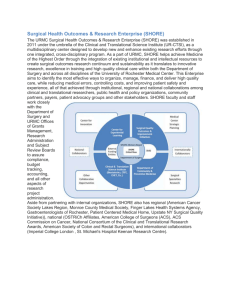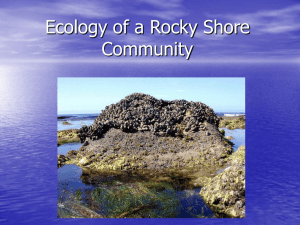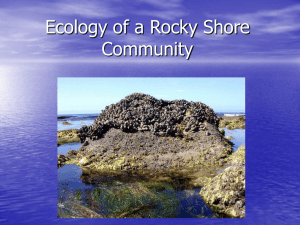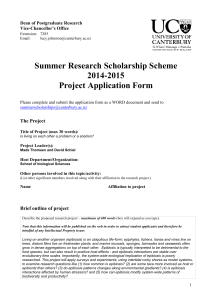handout rocky shore info
advertisement
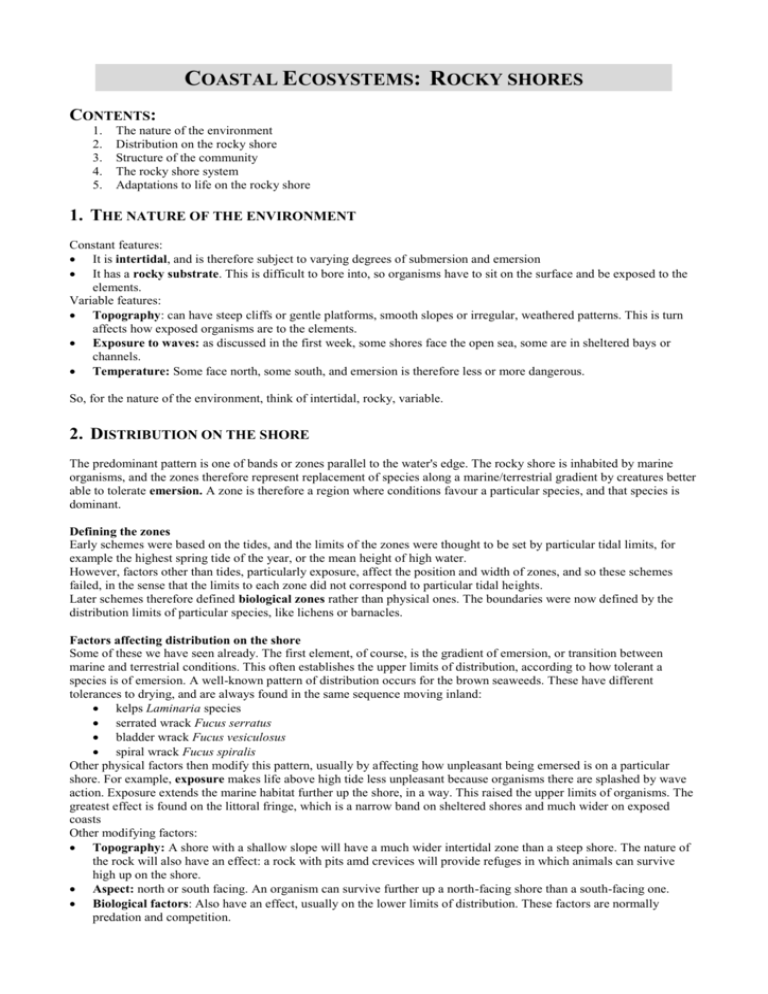
COASTAL ECOSYSTEMS: ROCKY SHORES CONTENTS: 1. 2. 3. 4. 5. The nature of the environment Distribution on the rocky shore Structure of the community The rocky shore system Adaptations to life on the rocky shore 1. THE NATURE OF THE ENVIRONMENT Constant features: It is intertidal, and is therefore subject to varying degrees of submersion and emersion It has a rocky substrate. This is difficult to bore into, so organisms have to sit on the surface and be exposed to the elements. Variable features: Topography: can have steep cliffs or gentle platforms, smooth slopes or irregular, weathered patterns. This is turn affects how exposed organisms are to the elements. Exposure to waves: as discussed in the first week, some shores face the open sea, some are in sheltered bays or channels. Temperature: Some face north, some south, and emersion is therefore less or more dangerous. So, for the nature of the environment, think of intertidal, rocky, variable. 2. DISTRIBUTION ON THE SHORE The predominant pattern is one of bands or zones parallel to the water's edge. The rocky shore is inhabited by marine organisms, and the zones therefore represent replacement of species along a marine/terrestrial gradient by creatures better able to tolerate emersion. A zone is therefore a region where conditions favour a particular species, and that species is dominant. Defining the zones Early schemes were based on the tides, and the limits of the zones were thought to be set by particular tidal limits, for example the highest spring tide of the year, or the mean height of high water. However, factors other than tides, particularly exposure, affect the position and width of zones, and so these schemes failed, in the sense that the limits to each zone did not correspond to particular tidal heights. Later schemes therefore defined biological zones rather than physical ones. The boundaries were now defined by the distribution limits of particular species, like lichens or barnacles. Factors affecting distribution on the shore Some of these we have seen already. The first element, of course, is the gradient of emersion, or transition between marine and terrestrial conditions. This often establishes the upper limits of distribution, according to how tolerant a species is of emersion. A well-known pattern of distribution occurs for the brown seaweeds. These have different tolerances to drying, and are always found in the same sequence moving inland: kelps Laminaria species serrated wrack Fucus serratus bladder wrack Fucus vesiculosus spiral wrack Fucus spiralis Other physical factors then modify this pattern, usually by affecting how unpleasant being emersed is on a particular shore. For example, exposure makes life above high tide less unpleasant because organisms there are splashed by wave action. Exposure extends the marine habitat further up the shore, in a way. This raised the upper limits of organisms. The greatest effect is found on the littoral fringe, which is a narrow band on sheltered shores and much wider on exposed coasts Other modifying factors: Topography: A shore with a shallow slope will have a much wider intertidal zone than a steep shore. The nature of the rock will also have an effect: a rock with pits amd crevices will provide refuges in which animals can survive high up on the shore. Aspect: north or south facing. An organism can survive further up a north-facing shore than a south-facing one. Biological factors: Also have an effect, usually on the lower limits of distribution. These factors are normally predation and competition. Large-scale distribution patterns As well as small-scale patterns: zones on particular shores, distribution can also be examined on a wider scale: why are species limited to shores in particular parts of the world, or to particular sites within a geographical region. The single most important factor here is temperature. All rocky shore organisms are restricted by their ability to withstand, at the one extreme, frozen water, and at the other, high summer temperatures. Another important influence is exposure again. This not only affects the width of zones, but can prevent species from living on shores where other physical conditions are suitable. For example, seaweeds are not usually found on exposed shores. In general, exposed shores have different communities from sheltered ones in the same region 3. COMPONENTS OF THE ROCKY SHORE COMMUNITY As we have just seen, this varies according to local conditions on the shore, particularly exposure. However, it is possible to make some general points about how rocky shore systems function. Producers On rocky shores the main producers are large seaweeds (algae). It is unusual for a coastal habitat (other than the salt marsh) to have large plants. It occurs here because: rock offers a stable platform for attachment. Of course, roots would be no use, so the plants are algae, which have a holdfast instead the water is shallow, giving enough light for photosynthesis. Note that algae lower down on the shore tend to have air bladders to keep themselves floating in the surface water. the water is rich in nutrients. The lowest shore is dominated by kelps, and is sometimes called the kelp forest. In Europe these are mainly species of Laminaria and can grow a few metres long. In California, S. Africa and the Falklands, the giant kelp Macrocystis pyrifera can reach 60m in length and may grow 18 inches in a day, reflecting the nutrient-rich conditions of shore life. Higher parts of the shore are dominated by fucoids (Fucus, Ascophyllum) which are much smaller plants Primary consumers The main consumers of kelp are sea-urchins. They tend to attack young plants or dead bits rather than mature plants. They can, however, be devastating: destruction of their predators (for example, sea-otters in California) can lead to complete destruction of the kelp forest. A few other herbivores, like the flat periwinkle can eat Laminaria. A greater variety of molluscs graze on fucoid seaweeds: limpets, periwinkles, topshells, but again they tend to concentrate on younger plants. Some animals do not graze the plant itself, but live on the material exuded through the surface: some of the tube-dwelling worms found on seaweed fronds, for example. It even seems that some herbivores are of benefit to the large algae, because they graze preferentially on the epiphytic plants that grow attached to the algal fronds. This appears to reduce the resistance of the fronds to water and so their rate of removal by waves. It also reduces shading of the fronds, increasing rate of photosynthesis. Rich communities develop on kelps and fucoids, some grazing on the plants, but some just using them for shelter or attachment. The microhabitat underneath the larger algae, for example, is much more humid than on bare rock. There is also a specialised habitat around the holdfast in more sheltered waters, where sediment is trapped and accumulates like a miniature mudflat. Higher consumers Invertebrate consumers include whelks, sea slugs and starfish Fish and shore birds are important vertebrate predators. Maintaining community structure The rocky shore is a crowded place: space is limited. How is such a variety of species maintained, rather than one coming to dominate ? One reason is the existence of environmental gradients, of course, allowing some species to survive in refuges where conditions are unfavourable for their competitors. Another is the existence of predators or grazers which act as keystone species, An example occurred with overfishing of lobsters in the North Atlantic. These had been important predators of sea urchins. Once they were removed, the sea urchins flourished and destroyed the kelp forests on which they grazed, together with the community that had survived on the kelp. Diversity was reduced. Control by predators like this, through reducing competition in lower trophic levels, is termed top-down control. It used to be seen as the most important mechanism on the rocky shore, where the lack of space and immobility of prey meant that predators could exert a far greater effect than in other habitats. More recently, other factors have begun to be recognised: Supply of colonisers: Immobile rocky shore organisms like barnacles reach new shores because they have mobile larvae, which swim in the plankton before settling on a shore. The number of larvae arriving at a site can vary from year to year and site to site, and lead to differences in the severity of competition at a particular site. For example, an inferior competitor might get a foothold on a shore if the supply of larvae of the dominant competitor failed for a year or two. Disturbance: a disturbed habitat constantly provides new areas for colonisation, preventing any one species from dominating. On the rocky shore, storms can provide this disturbance. Crowding also has an effect: mussels and barnacles, for example, grow on top of one another once all the rock is covered. The bottom layers are then smothered, die, and the whole pile can be swept away from the rock. Nutrient supply: in areas of high nutrient availability, such as upwelling areas like that off the coast of Oman, algae may grow quickly enough to overcome grazing pressure. Control in this case is termed bottom-up in contrast with control from higher trophic levels. 4. THE ROCKY SHORE SYSTEM The influence of nutrient supply is one element of how the rocky shore can be considered as an ecosystem, with its fundamental processes of nutrient cycling and energy transfer. Primary production: for the kelp forest is amongst the highest of all ecosystems, often exceeding a kilogram of carbon per square metre of shore per year. Intertidal seaweed beds are also highly productive, producing several hundred g/sq metre/year. 90% of this production is not grazed directly, but enters the detrital pathway, either as detritus particles or as dissolved organic matter. This material is then consumed by organisms such as mussels and barnacles. Much of it is also exported from the area, so that rocky shores are usually very 'leaky' systems, rather than being tightly closed in the way that a temperate woodland, for example, is. Other producers on the rocky shore are the microalgae which form a film on the rock surface and are grazed by organisms like limpets. On more exposed shores, where the big seaweeds are uncommon, the microalgae make the more significant contribution to production. On such shores, the system as a whole is likely to be a net importer of primary production, whereas more sheltered shores tend to be net exporters. Compare the point made here, that higher-level consumers like whelks are insignificant in terms of energy flow, with one of the points above, that whelks can be keystone species influencing the whole structure of the community. There are different ways of assessing importance. Whelks may consume a tiny proportion of the production of seaweed, but they may still control, through their effects on herbivores, whether the seaweed is there or not. 5. ADAPTATIONS TO ROCKY SHORE LIFE Coping with emersion We have seen that the emersion gradient is significant in establishing distribution on the shore. On mid and upper-shore species, we can expect to find adaptations that help them to cope with desiccation and temperature extremes. Sealing: Most animals seal themselves in. This can be done with a shell: periwinkles close the opening of their shells with an operculum, bivalves like mussels close up the two valves of the shell. Mucus can also help. Limpets seal their shells with a layer of mucus. Some periwinkles use mucus to hang away from the hot surface of the rock. Shape: Limpets on the upper shore are higher-domed than lower-shore limpets. This shape reduces the ratio of shell aperture to total body size and means that a limpet can grow without losing more water from the aperture. Seaweeds on different parts of the shore also tend to have different shapes. Species of the upper shore tend to be smaller and rounder, reducing their surface area and so reducing water loss. Respiration: Rocky shore organisms are like fish - they are adapted to extract oxygen from water, so how do they cope when the tide is out ? Limpets show a number of adaptations that allow them to keep a flow of water passing over the gills. Keyhole limpets, for example, fan water from the rock surface over the gills and out of the 'keyhole' at the top of the shell. The common limpets Patella have secondary gills around the margin of the shell, and these use the water trapped on the rock surface around the edge of the gill. Most of these organisms can also slow or stop aerobic respiration if conditions are serious: the advantage is that respiration involves water loss and increases the risk of desiccation. They respire anaerobically, as we do when running fast, but with the difference that they can tolerate the resulting 'oxygen debt' for much longer - until the tide comes back in. Surviving freezing: Species of higher latitudes show great tolerance to freezing. The periwinkle Littorina littorea, for example, can survive to -20 C, at which point 75% of its body water is frozen. The cause of death in freezing conditions is actually osmotic. Fluids outside the cells freeze, and as this happens the fluid remaining becomes more concentrated. This then pulls water out of the cells through osmosis, until the cells are killed. Many rocky shore organisms counter this by producing 'antifreeze' substances in their cells, which counter the osmotic effects of outside fluids, and also prevent fluids inside the cells from freeaing. Coping with exposure: This is a matter of holding on to the rock against the force of the waves. Seaweeds produce a holdfast, a structure which holds them through a combination of sticky mucus and growth into irregularities on the surface of the rock. So they have chemical and mechanical attachment. Animals produce glues. In mussels and barnacles, there are two materials produced by different glands, equivalent to a glue and hardener in something like Araldite. Glues like this, that work underwater, have been of considerable interest to industry. Limpets are not permanently attached, and use mucus. The stickiness of the mucus varies, so that the bond is stronger when the tide is in, and if the limpet is on an exposed shore. There also seems to be a suction component with limpets. Shape changes also help organisms to cope with exposure. Kelps, for example, grow more streamlined blades and divide each blade into narrow streamers under more exposed conditions. This occurs within species: different individuals change their shape according to local conditions. Animals show shape differences too. Limpets tend to be flatter in more exposed situations, and whelks have larger apertures relative to their body size. Summary The rocky shore presents obvious physical challenges to its inhabitants. The results of these can be seen in distribution on both local and larger scales, in differences in community structure, and in adaptations. Rocky shores have complex communities in spite of the lack of space. Interactions like predation, and physical factors such as disturbance help to maintain high diversity. Productivity is high, with most entering the detritus rather than the grazing pathway.

